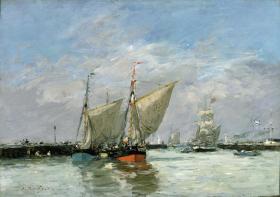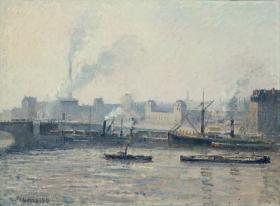1. Have students create a windowpane foldable with four flaps for notes on clouds. Instruct students to label each flap with one type of cloud: cirrus, stratus, cumulus, cumulonimbus.
2. Have students count off by fours. Assign one type of cloud for each number (1–cirrus, 2–stratus, 3–cumulus, 4–cumulonimbus).
3. Show the Types of Clouds video. Ask students to take notes under the flap of the foldable on the type of cloud that was assigned to their number.
4. Once video is complete, have students get into groups based on the type of cloud they took notes on during the video (for example, students who took notes on cirrus clouds should be together). Students should work together, share notes, and use the textbook and Internet resources to describe their type of cloud. Students in each group should become "experts" about their type of cloud. Students will finish by drawing a picture of their type of cloud on the outside flap of the foldable and writing a description and any other facts under the flap.
5. Rearrange the students into new groups of four. Each of the four students should be an "expert" about one of the four different types of clouds. Within the group, students will teach each other about their cloud type. During this time, students should complete their foldables with a drawing of the cloud on the front of the flap and facts on the inside.
6. To review the types of clouds and the altitudes where they are formed, instruct students to complete the Types of Clouds Worksheet.
7. Review students' answers to worksheet. Discuss types of clouds and the weather that is associated with each type.
8. An extension to review the cloud types is to show the Types of Clouds Music Video or the Types of Clouds PowerPoint Presentation. During the PowerPoint, students can write answers on individual whiteboards or discuss as a class.
9. Introduce students to Boudin's Trouville, The Jetties, High Tide. Discuss the painting as a group. Appoint a note taker to write down students' responses to questions. Questions may include:
- What do you see in this painting? (Students should point out things that are observable in the painting)
- What type of clouds do you notice? (Students should conclude the clouds are either cumulus or cumulonimbus)
- Describe what you think the weather would be like if you were able to step into this painting. (Students should describe temperature, wind speed, season, etc.)
- What clues helped you determine the temperature and type of weather in the painting? (bright sunlight, shadows in water, cool colors giving clues regarding the temperature, full sails, flag blowing)
-Do you think the artist painted this scene outside or inside? (Painted most of it outside)
-Name some advantages/disadvantages of working outside. (Answers will vary)
-Name some advantages/disadvantages of working inside. (Answers will vary)
10. Give background information about en plein air painting. Tell students that Boudin painted outdoors and encouraged others to do the same. As a class or in small groups, have students brainstorm materials that an artist might need to paint outside. Appoint a note taker for each group or the whole class to make a list of the materials. Discuss items that may be missing from the lists. Items may include portable easel, palette, paint tubes, weather gear (sweater, umbrella, hat, etc.), glasses, brushes, portable stool or chair, sketchbook, canvases, pencils, etc.
11. Discuss as a class which of these items would have been available to Boudin during the time that he completed this painting (around 1876). Ask: What items would not have been available? (plastic containers, sunscreen, cell phone with Internet access for a weather report).
12. Discuss the role of technology in preparing for weather. Ask: What do you need to know before you spend the day outside? (temperature, precipitation, how to dress) How do you find out what the weather will be? (Web site, TV report, newspaper) How do you think Boudin and other artists prepared themselves for painting outside without having a weather forecast on the morning news? (clouds, climate information, almanac)
13. Refer back to the students' responses to the discussion questions about Boudin's Trouville, The Jetties, High Tide. Using the students' responses, work as a class to put a weather report together for this painting. Remind students of the important elements of forecasting the weather (temperature, wind speed, wind direction, precipitation). Demonstrate a sample weather report about the Boudin painting.
14. Tell students that they will be working in a group to create a weather report for either a French or an Italian painting. Divide the class into groups and assign each group one of the following paintings:
- Capriccio: The Rialto Bridge and The Church of S. Giorgio Maggiore by Giovanni Antonio Canal (Italian)
- The Cliff, Étretat, Sunset by Claude Monet (French)
- The Grand Canal at the [Rio di] Ca’ Foscari by Michele Marieschi (Italian)
- The Saint-Sever Bridge, Rouen: Mist by Camille Pissarro (French).
15. Ask students to discuss the painting within their groups. Have students complete the Weather or Not Data Handout during the group discussion. Students should use the Weather or Not Forecast Tools Handout and their cloud foldable to determine the weather forecast.
16. Students should use the information to come up with a creative weather forecast presentation. Students can use props, poster board, costumes, etc. to present their forecast.
17. Project each painting and allow students to present their weather reports. Discuss the elements of the painting and the evidence that the students used to determine the weather conditions.
18. Allow students to create their own cloud paintings. Students should use the NCMA paintings from the weather reports as inspiration. Students should show a specific type of cloud in their painting as well as evidence of specific weather conditions.
19. As an alternative assignment, instead of having students create a cloud painting indoors, have students organize materials and go outside to draw or create small en plein air paintings. Encourage students to work quickly to capture the quality of light and weather conditions.
20. Ask students to complete a reflection about their cloud painting. Project the Cloud Painting Reflection PowerPoint for students to reference.
- Types of Clouds Worksheet will demonstrate students' understanding of types of clouds and weather associated with each cloud.
- Weather or Not Data Handout will assess students' discussions and analysis of the painting. Rubric will assess discussion, answers, and presentation.
- Class discussion and group lists can be used to assess students' analysis of weather data and factors.
- Cloud painting and reflection will demonstrate students' ability to use observation skills and different techniques to create art.
cirrus clouds
stratus clouds
cumulus clouds
cumulonimbus clouds
en plein air
Paper for foldable
Crayons or colored pencils for foldable
Cardstock for painting
Paint
Paint brushes
Projector
Props, costumes, poster board, etc. for weather report presentations
Types of Clouds Internet Resources
- http://science.howstuffworks.com/dictionary/meteorological-terms/cloud1.htm
- http://science.nationalgeographic.com/science/earth/earths-atmosphere/clouds-article/
- http://students.estrellamountain.edu/drakuna/studentfrontpageprojects/DavidIreland/new_page_3.htm
- http://asd-www.larc.nasa.gov/SCOOL/tutorial/clouds/cloudtypes.swf
- http://wvscience.org/clouds/Cloud_Key.pdf
Types of Clouds Worksheet
Types of Clouds Music Video
The Grand Canal at the [Rio di] Ca’ Foscari by Michele Marieschi
Boudin was born in Normandy on the north coast of France, where he developed a love for marine subjects. For a time he operated a frame shop in Le Havre, and after leaving it, he continued to display his paintings there. In 1858 he encountered a young caricaturist showing his drawings at the same location. The artist was 18th-year-old Claude Monet, who initially disliked Boudin’s fresh style of brushwork. Later, however, Monet credited the older painter with encouraging him to buy his first box of paints and to paint outdoors on the beaches: “So one day I joined Boudin in painting outdoors. I began to daub my canvas. Then I watched him paint. And suddenly, I was overcome by a deep emotion . . . more, I was enlightened.” This example of Boudin’s later work shows the influence of the younger impressionist in the freedom from detail, the interest in light, and the unifying effects of bravura brushwork.
Trained by his father, a painter of theatrical scenery, Canaletto specialized in views of his native Venice. By the 1730s, he was one of the most successful artists in Europe, his most avid patrons being the English aristocrats who came to Venice on their ‘Grand Tours’ of Europe and commissioned painted views of the city as souvenirs of their visits. Canaletto’s precise technique helped to invest these views with the illusion of topographical accuracy. A contemporary wrote: “He paints with such accuracy and cunning that the eye is deceived and truly believes that it is reality it sees, not a painting.” However, the artist often subtly adjusted architectural details, viewpoints, and topography to create a more picturesque and harmonious work of art; on occasion, he took even greater artistic license. This painting combines in a single setting three famous landmarks from different areas of Venice: the church of San Giorgio Maggiore, designed by the famous architect Palladio and located on an island at the entrance to the Grand Canal; the Rialto Bridge; and at left, the Palace of the Ten Wise Men. The Italian word capriccio, meaning whim or fancy, is used to describe these fanciful compositions.
The Cliff, Etretat, Sunset is a typical example of the impressionist style, demonstrating an interest in atmospheric conditions and the effects of light as the day progresses. Colors are vibrant and applied to the canvas in separated brushstrokes that create the illusion of motion on the water’s surface. Close examination of the setting sun reveals Monet’s technique of applying one color of paint over another that is still wet. He thus achieved a partial mixture, not a thorough blending of the colors as traditional painters had done on their palettes.
The monumentality of the famous cliffs at the resort of Etretat in Monet’s native Normandy distinguishes them from most of his other subjects. The rock formations are known as the Elephant and the Needle because of their shapes.
Few subjects recall the impressionists’ fascination with changing effects of atmosphere and water as much as Pissarro’s view of Rouen. Among the members of this group, Pissarro was the most receptive to experimentation with new ideas and approaches. Having painted in Rouen earlier, Pissarro was drawn back to the city in 1896 by Claude Monet’s success with a series of paintings of Rouen Cathedral. He selected a less monumental subject than Monet’s cathedral, preferring the distant views of the Seine bridges visible from his hotel window. Pissarro completed 16 canvases of the bridges that year, delighted by the combination of natural mist and the smoke from boats and factories. Like Monet’s cathedrals, Pissarro’s Rouen bridge paintings vary greatly in color and quality of light, depending on time of day and weather conditions. He wrote to his son Lucien of his work, saying, “what interests me especially is a motif of the iron bridge in the wet, with much traffic, carriages, pedestrians, workers on the quays, boats, smoke, mist in the distance, the whole scene fraught with animation and life.” Such urban scenes are more frequent in Pissarro’s oeuvre than in that of any other major impressionist.




